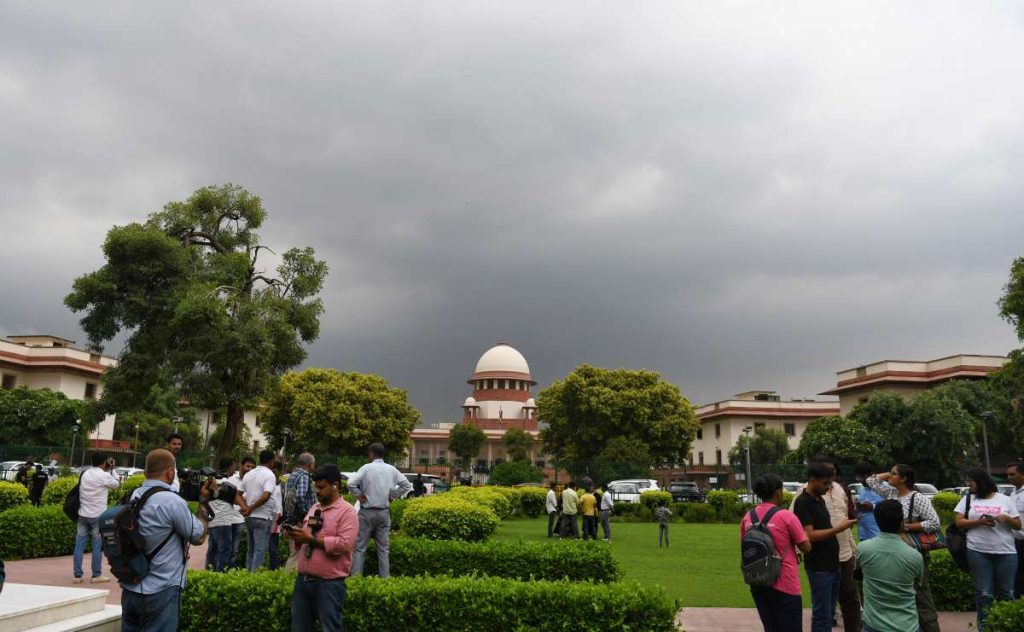The removal of the blindfold from ‘Lady Justice’ is more than a visual change—it symbolises a shift in how the judiciary views justice in modern India….reports Asian Lite News
The Supreme Court (SC) of India has unveiled a redesigned version of the ‘Lady Justice’ statue, marking a significant departure from its colonial past. Traditionally depicted with a blindfold and a sword, the new statue now features ‘Lady Justice’ with open eyes and the Constitution of India in place of the sword, reflecting the judiciary’s commitment to constitutional values and justice that “sees everyone equally”, reported NDTV.
The removal of the blindfold from ‘Lady Justice’ is more than a visual change—it symbolises a shift in how the judiciary views justice in modern India. The blindfold, long associated with impartiality and equality before the law, has been replaced with open eyes, a bold statement led by Chief Justice of India D Y Chandrachud.
“The law is not blind; it sees everyone equally,” CJI Chandrachud said during the unveiling.
This change, according to sources in the Supreme Court, reflects an evolving legal identity—one that distances itself from colonial symbols and embraces a uniquely Indian interpretation of justice. The updated statue now stands proudly in the judges’ library, embodying a justice system that is aware, vigilant, and inclusive.
Another striking feature of the new ‘Lady Justice’ is the replacement of the sword with the Constitution. While the sword previously represented authority and punishment, its replacement with the Constitution signifies a shift towards a more principled and balanced approach to justice. The Constitution, as the foundation of the judiciary’s role, represents the upholding of rights, equality, and fairness over mere retribution.

A senior official from the Chief Justice’s office explained, “The sword is a symbol of violence, but courts deliver justice according to constitutional laws. The new statue aims to reflect this principle.”
The redesign of ‘Lady Justice’ aligns with a broader effort by the Indian judiciary to shed its colonial past. Recent legal reforms, such as the introduction of the Bharatiya Nyaya Sanhita (BNS) to replace the Indian Penal Code (IPC), underscore this movement. CJI Chandrachud has been vocal about the need to break away from British-era symbols and laws, emphasising that the judiciary’s role is not punitive but protective of constitutional rights.
As noted by a source close to the Chief Justice, “Justice Chandrachud believes that India should move forward from the British legacy, and that the law is never blind; it sees everyone equally.” This philosophy is embodied in the redesigned ‘Lady Justice,’ which now represents the Constitution as the ultimate source of justice.
Despite the changes, one aspect of ‘Lady Justice’ remains unchanged—the scales in her right hand, which continue to represent the balance of justice. These scales symbolise the impartial weighing of evidence, ensuring that both sides are considered equally before a verdict is reached.
“The scales of justice represent balance in society, and the idea that facts and arguments by both sides are weighed by courts before arriving at a conclusion,” said an official.

CJI proposes Justice Khanna’s name as his successor
Chief Justice of India (CJI) Chandrachud has formally proposed Justice Sanjiv Khanna, the second-most senior judge of the Supreme Court, as his successor.
In a communication to the Union government, Chief Justice Chandrachud stated that since he is demitting office on November 10, Justice Khanna would be his successor.
Upon approval by the government, Justice Khanna will become the 51st Chief Justice of India. He is set to serve a tenure of six months, concluding on May 13, 2025, before his retirement.
The letter is written as per convention where the retiring Chief Justice of India nominates the second-most senior judge a successor. The Union government then approves the recommendation.
Justice Chandrachud took over as the CJI on November 9, 2022. Judges of the Supreme Court retire by the age of 65.
Born on May 14, 1960, Justice Khanna enrolled as an advocate with the Bar Council of Delhi in 1983 and initially practised at the district courts at the Tis Hazari complex, and later in the High Court of Delhi and tribunals.
He was elevated as an additional Judge of the Delhi High Court in 2005 and was made a permanent judge in 2006.
Justice Khanna was elevated as a Judge of the Supreme Court on January 18, 2019.
Dhananjaya Yeshwant Chandrachud, born November 11, 1959, is an Indian jurist, who is the 50th and current chief justice of India serving since November 2022.
He was appointed a Judge of the Supreme Court of India in May 2016 and also previously served as the chief justice of the Allahabad High Court from 2013 to 2016 and as a judge of the Bombay High Court from 2000 to 2013.
CJI Chandrachud was educated at Delhi University and Harvard University and has practised as a lawyer for Sullivan& Cromwell and in the Bombay High Court.
He has been part of benches that delivered landmark judgments such as the electoral bond scheme verdict, the Ram Janmabhoomi verdict, the Sabarimala case, the same-sex marriage case and on revocation of the special status of Jammu and Kashmir. (ANI)
ALSO READ: SC to hear plea for restoration of J&K’s statehood













